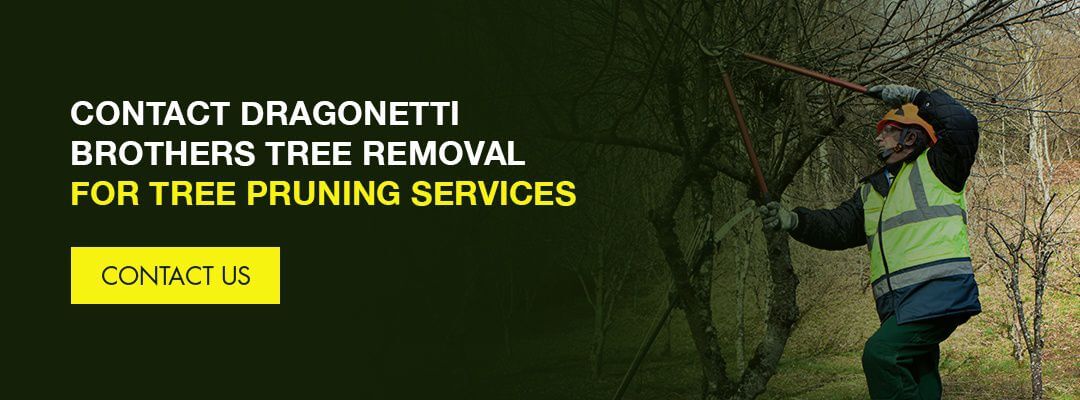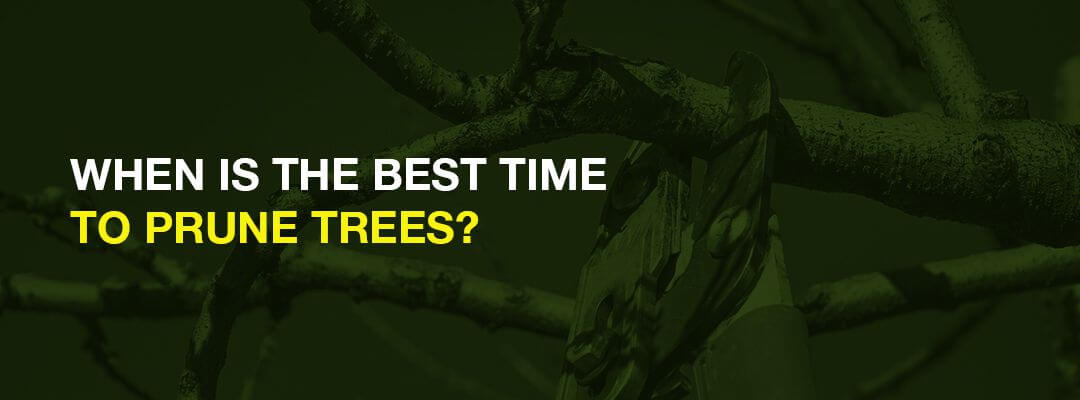
Urban and rural areas are like night and day. While urbanized areas such as New York City are all about avocado toast and expensive martinis, rural dwellers enjoy amenities like rustic cabins and lakes fit for fishing.
Even the trees look different. In forests, trees are free to grow every which way, while urban trees are more reserved to accommodate walkways, road patterns and the concrete jungle.
When is the best time to cut tree branches? As we approach the winter months, now is the ideal time of year to prune most of your trees in preparation for next year’s growing season. Arborists know when to prune trees to keep them healthy year-round.
Here, our arborists will walk you through the best pruning methods, analyze when is the best time to trim tree branches and outline the tools you need to keep your trees healthy and compatible with the New York City lifestyle.
WHY IS TREE PRUNING ESSENTIAL?
Tree pruning is crucial for the safety of people as well as the tree itself. More specifically, tree pruning plays a vital role in the following areas.
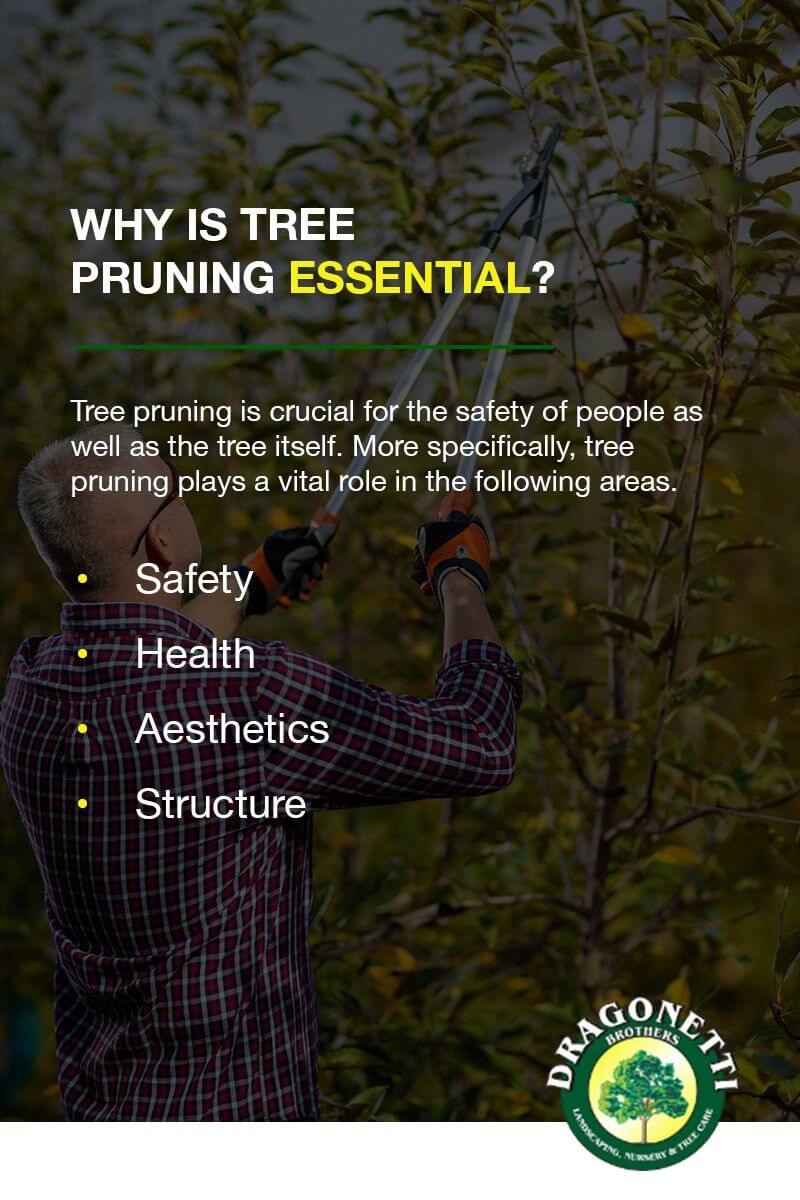
- Safety: There’s no one around to say “Timber!” fast enough if a dead branch comes hurtling your way. Trees lose limbs for various reasons, like poor health or extreme weather conditions. While pruning, arborists look for these safety hazards and remove them before they have the chance to hurt someone or something.
- Health: Just like people, trees experience illness and injury. Sick, rotting and insect-infested wood creates a safety hazard for the same reasons outlined above. Arborists strategically remove these unhealthy areas because, if done wrong, pruning may lead to worsening tree well-being.
- Aesthetics: Twisted, gnarled branches may have their place in a sprawling forest, but in the city, they’re unattractive. Luckily, arborists can remove these extra growths and make trees look clean and put-together, almost like when people trim the dead ends off their hair.
- Structure: When should you cut tree limbs? Ideally, pruning begins when a tree is young, but there’s no wrong age to start pruning. Pruning encourages trees to grow and thrive, limiting their chances of getting sick and injured.
Trees reap the benefits of pruning only when done right. Plus, pruning methods aren’t the same for every tree, which is especially true when pruning different species.
TREE PRUNING ADVICE BY TREE TYPE
You won’t prune Southern magnolias the same way as flowering dogwoods — they’re two different tree species with varying blooming periods.
When do you prune trees? In general, you want to do so in correspondence with their growth patterns. When pruning trees, you’re technically creating an open wound, strategically timed so that the tree can heal itself over time.
Arborists strategize their pruning based on two generalized types.
EARLY-BLOOMING TREES
Early-blooming trees are the first to herald spring’s arrival. A typical example is the cherry tree, beloved for its beautiful, delicate pink blossoms.
Early-blooming trees start budding based on last year’s growth. They work all summer to prepare for next spring, and if you prune over winter, you’ll detract from all this effort.
Because of this, these are the single tree types we don’t recommend PRUNING DURING THE WINTER. Instead, prune them right after they finish blooming in the middle of spring.
LATE-BLOOMING TREES
Late-blooming trees flourish later in the spring season, right after early-blooming trees do. That’s because late-blooming trees spend the early springtime building new growth for them to showcase later in the season.
Prune these tree types during the winter, or right before springtime at the very latest. Late-blooming trees are dormant during the spring, and they’ll quickly repair their wounds once they renew their growth.
HOW TO PRUNE A TREE
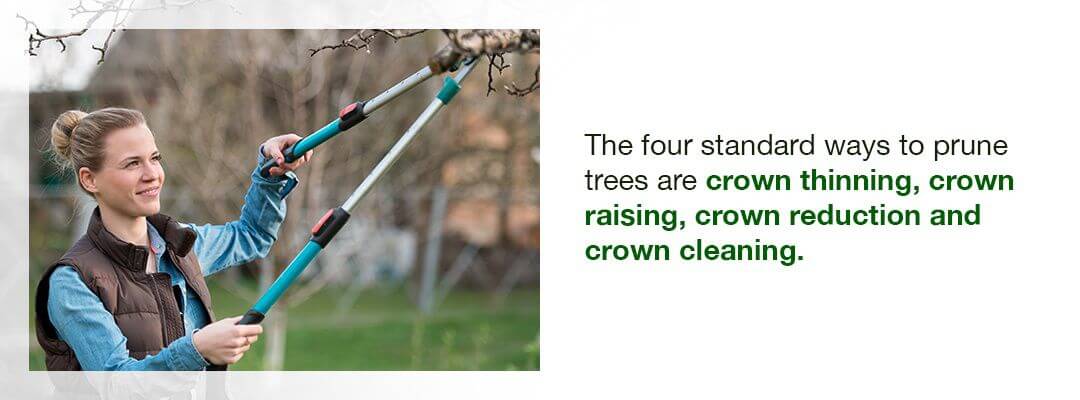
The four standard ways to prune trees are crown thinning, crown raising, crown reduction and crown cleaning. But first, what is the “crown” of a tree?
The tree’s crown is any point where branches stem from the trunk. If you look at a tree branch near this point, you’ll notice a slight swelling.
The crown is almost like the “bud” of the tree. Its role is to support the tree branch and promote healthy growth, but sometimes the tree unknowingly encourages the wrong type of growth, which is where pruning plays a crucial role.
Now, depending on your tree and each unique crown’s needs, let’s examine the different pruning methods you can use to support healthy growth.
1. CROWN THINNING
Trees do a great job of gathering nutrition to grow robust branches and lush leaves. However, sometimes they go a little overboard, which requires what arborists call crown thinning.
Tree specialists usually perform crown thinning on mature trees. The process reduces the tree’s overall density by cutting no more than 10 to 20% of the branches. Removing these crowded branches increases the available sunlight and improves its circulation, so the tree has breathing room to grow.
When cutting back the tree branches, an arborist’s goal is to remove a strategic amount of branches, so the tree doesn’t appear sparse or diminished. For larger trees, the goal is to remove the ends of branches, usually anywhere between 1 to 4 inches in diameter. Comparatively, for smaller ornamental trees and fruit trees, arborists remove smaller branches between a quarter to a half-inch thick.
You can safely prune branches under 2 inches by yourself, but we recommend sticking with the professionals for anything thicker, or you risk harming yourself and the tree.
2. CROWN RAISING
While crown thinning aims to reduce trees’ density, crown raising focuses on the starting point of the entire branches’ growth on the tree trunk, or the height at which said growth starts.
Arborists usually perform crown raising as a safety measure, like for car or foot traffic, so cars or pedestrians don’t run into any branches. Also, crown raising is usually a drawn-out process, because pruning too much at once can negatively impact future growth.
When crown raising annually, you should prune only a few tree limbs under 4 inches thick in diameter. As you cut, take a step back and look at the balance between the tree trunk and live crowns. The preferred ratio is 40% trunk and 60% live crown.
3. CROWN REDUCTION
The ideal tree branch grows laterally. A single branch can have many other growths — small, connected branches — that grow upward, downward or laterally.
If all a tree’s branches are growing this sporadically, they’ll crisscross each other, limiting the breathing room the tree needs to be healthy. To solve this, arborists use the crown reduction technique.
Crown reduction is a gentler alternative compared to the other methods we’ve outlined here. Instead of cutting at the crown from the tree trunk, the tree specialist cuts at smaller crowns on a single tree branch. More specifically, arborists cut intertwining branches.
Pruning tree branches promotes healthier growth. Cutting these improperly shaped branches encourages new growth in the correct direction.
4. CROWN CLEANING
Crown cleaning is another exception to the winter pruning rule — you can, and should, practice this technique year-round.
This pruning method removes any diseased or broken branches that negatively impact the tree’s overall health. Even amateur arborists can usually spot a dead or infected branch, noted for their brown or sickly green color.
If you don’t remove these infected or dead areas, rot and illness can spread throughout the trunk, eventually killing the entire tree.
THE THREE-STEP METHOD — THE CORRECT WAY TO PRUNE A TREE
The most natural approach to cutting a tree limb is to cut straight down and through it. But, if you try this once, you’ll quickly notice a glaring problem — the branch rips past the initial cutting point, painfully stripping the tree down the trunk.
Instead of harming your tree even further, practice a safer pruning method that arborists call the three-step method. How do you prune a tree with this technique?
Using your pruning saw — a pruning tool we’ll mention in the next section — make your first cut about half a foot to a foot away from the branch’s crown. Cut going up from under the branch, sawing about halfway through the branch’s diameter.
Then, go another 4 inches above this cut, and make your second cut. From the top going down into the branch, cut the branch off entirely. The first cut you make will act as a buffer, capturing the branch’s weight and preventing any splitting.
Then, make your last cut at the base of the crown. This cut is your most crucial. You don’t want to cut into the crown, or it can invite infection into the trunk and do more damage than good. Or, if you don’t cut closely enough, the tree won’t be able to heal completely. Find the crown’s sweet spot and make your last cut.
WHAT YOU NEED TO PRUNE TREES
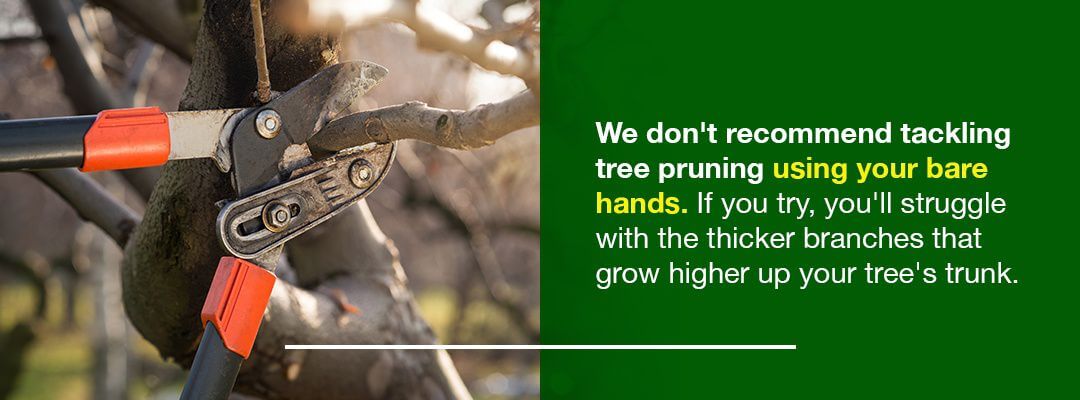
We don’t recommend tackling tree pruning using your bare hands. If you try, you’ll struggle with the thicker branches that grow higher up your tree’s trunk.
If you plan on doing essential maintenance, we recommend keeping a pair of pruning shears and a saw in your arborist tool collection. Or, if you are ready and willing to make more professional cuts, add a pair of loppers and a pole saw to that collection.
A well-rounded amateur arborist should have the following tools.
PRUNING SHEARS
Most people already have a pair of pruning shears. They’re handheld tools that look like large garden scissors. You can use pruning shears on trees and shrubs alike to cut branches up to three-quarters of an inch thick.
There are three types of pruning shears.
- Bypass pruners: When people think of pruning shears, they probably envision bypass pruners. These have two curved blades that bypass each other to cut a live branch.
- Anvil pruners: Comparatively, anvil pruners have two blades that don’t pass each other and are best for cleanly cutting dead branches.
- Ratchet pruners: Ratchet pruners are very similar in design and function to bypass pruners but are easier for people with sensitive wrists to use.
We suggest having a pair of bypass and anvil pruners in your arborist tool collection for best practices.
LOPPERS
Loppers are like larger pruning shears. Their thicker blades make them well-suited to tackle thicker and bigger branches, usually up to 2.5 inches in diameter.
Loppers also have larger, longer handles that require both hands to use. The larger size gives loppers their strength, and they can also reach higher branches than pruning shears.
Like pruning shears, loppers are also available in anvil, bypass and ratchet styles.
PRUNING SAW
When considering tree saws, there are a few different styles designed for various tasks. For example, a traditional wood saw is for cutting firewood. Pruning saws are sharper than other wood saw types and are meant for cleanly cutting live branches.
Use a pruning saw rather than pruning shears when working with longer or thicker branches. Pruning saws are suitable for branches anywhere from 1.5 to 5 inches thick, and it’s best to use them when practicing the three-step method we outlined earlier.
POLE SAW AND PRUNER
For your safety, we recommend sticking with the professionals for tree branches out of your reach. But, if you’ve decided to take a DIY approach to pruning these branches, use a pole saw and pruner.
Pole saws and pruners are two-in-one saws and pruners, as you may have guessed, but they have a much longer handle to reach 8 feet high or higher. They’re also available in electric options to make pruning easier.
HOW TO CARE FOR YOUR TOOLS
After your pruning session, you’ll notice your tools are a bit messy, especially if you are cutting live branches. Tree sap sticks to pruning tools’ metal blades, and if you neglect to clean it off, it can make your pruners dull and sticky.
Also, because the blades are metal, they will rust if exposed to rain or moist climates. Because of this, we recommend keeping your tools inside and thoroughly wiping off any moisture after removing all traces of sap.
CONTACT DRAGONETTI BROTHERS TREE REMOVAL FOR TREE PRUNING SERVICES
Do you prefer to rely on professionals to know when to trim trees to ensure they thrive in every season? Contact DRAGONETTI BROTHERS TREE REMOVAL, and we’ll take care of it for you. Whether for residential or commercial purposes, there’s no project too big or too small!
Our arborists are detail-oriented, with customer satisfaction at the core of everything we do.
Contact us today for a free tree pruning estimate. We’ll work with you to answer any questions or concerns you might have, and our arborists will respond promptly with a reliable solution.
